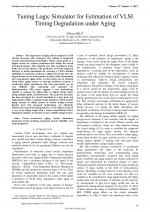| 3/2019 - 9 |
Tuning Logic Simulator for Estimation of VLSI Timing Degradation under AgingMILIC, M. |
| View the paper record and citations in |
| Click to see author's profile in |
| Download PDF |
Author keywords
accelerated aging, circuit simulation, integrated circuit modeling, integrated circuit reliability, very large integration
References keywords
reliability(12), aging(10), design(9), analysis(8), timing(7), circuits(7), statistical(5), microelectronics(5), jmicrorel(5), vlsi(4)
Blue keywords are present in both the references section and the paper title.
About this article
Date of Publication: 2019-08-31
Volume 19, Issue 3, Year 2019, On page(s): 75 - 82
ISSN: 1582-7445, e-ISSN: 1844-7600
Digital Object Identifier: 10.4316/AECE.2019.03009
Web of Science Accession Number: 000486574100009
SCOPUS ID: 85072177529
Abstract
The importance of aging effects analysis in VLSI circuits increases with nowadays fast scaling of integrated circuits manufacturing technologies. Delays along paths in a digital circuit are crucial parameters that define the circuit working frequency. They degrade over time resulting in delay faults and circuit failures. The prediction of circuit long-term behavior is useful mechanism for ensuring a VLSI's lifetime reliability. In particular, paths in a digital circuit that have the largest delays are the most sensitive to gates' delay fluctuations, and consequently aging. Delay of those paths can be obtained using either aging sensors or through statistical analysis of accelerated aging experiments, but such approaches can be very difficult, time consuming and expensive for implementation. This paper suggests a new methodology capable to estimate the aging effect to digital circuit delays along multiple paths, simultaneously. The proposed technique has been developed for circuits described at a gate level, and implemented within a standard logic simulator, which enables aging analysis in initial phases of system design process. Results show that proposed methodology can efficiently estimate the long-term timing behavior of the digital circuit in a very early design stages with a small computational effort, helping the designer in selection of most reliable design choices. |
| References | | | Cited By |
Web of Science® Times Cited: 0
View record in Web of Science® [View]
View Related Records® [View]
Updated 2 days, 3 hours ago
SCOPUS® Times Cited: 0
View record in SCOPUS® [Free preview]
There are no citing papers in the CrossRef Cited-by Linking system.
Disclaimer: All information displayed above was retrieved by using remote connections to respective databases. For the best user experience, we update all data by using background processes, and use caches in order to reduce the load on the servers we retrieve the information from. As we have no control on the availability of the database servers and sometimes the Internet connectivity may be affected, we do not guarantee the information is correct or complete. For the most accurate data, please always consult the database sites directly. Some external links require authentication or an institutional subscription.
Web of Science® is a registered trademark of Clarivate Analytics, Scopus® is a registered trademark of Elsevier B.V., other product names, company names, brand names, trademarks and logos are the property of their respective owners.
Faculty of Electrical Engineering and Computer Science
Stefan cel Mare University of Suceava, Romania
All rights reserved: Advances in Electrical and Computer Engineering is a registered trademark of the Stefan cel Mare University of Suceava. No part of this publication may be reproduced, stored in a retrieval system, photocopied, recorded or archived, without the written permission from the Editor. When authors submit their papers for publication, they agree that the copyright for their article be transferred to the Faculty of Electrical Engineering and Computer Science, Stefan cel Mare University of Suceava, Romania, if and only if the articles are accepted for publication. The copyright covers the exclusive rights to reproduce and distribute the article, including reprints and translations.
Permission for other use: The copyright owner's consent does not extend to copying for general distribution, for promotion, for creating new works, or for resale. Specific written permission must be obtained from the Editor for such copying. Direct linking to files hosted on this website is strictly prohibited.
Disclaimer: Whilst every effort is made by the publishers and editorial board to see that no inaccurate or misleading data, opinions or statements appear in this journal, they wish to make it clear that all information and opinions formulated in the articles, as well as linguistic accuracy, are the sole responsibility of the author.





